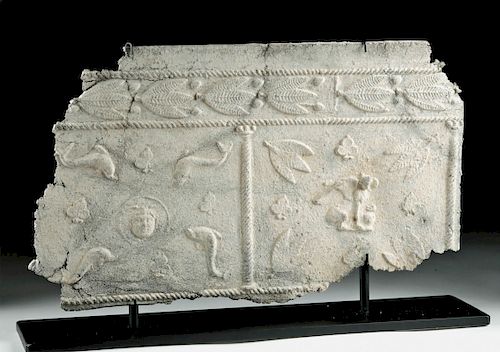Roman Lead Sarcophagus Panel, Medusa, Dolphins, Griffin
Lot 76a
About Seller
Artemis Gallery
686 S Taylor Ave, Ste 106
Louisville, CO 80027
United States
Selling antiquities, ancient and ethnographic art online since 1993, Artemis Gallery specializes in Classical Antiquities (Egyptian, Greek, Roman, Near Eastern), Asian, Pre-Columbian, African / Tribal / Oceanographic art. Our extensive inventory includes pottery, stone, metal, wood, glass and textil...Read more
Estimate:
$2,200 - $3,300
Absentee vs Live bid
Two ways to bid:
- Leave a max absentee bid and the platform will bid on your behalf up to your maximum bid during the live auction.
- Bid live during the auction and your bids will be submitted real-time to the auctioneer.
Bid Increments
| Price | Bid Increment |
|---|---|
| $0 | $25 |
| $300 | $50 |
| $1,000 | $100 |
| $2,000 | $250 |
| $5,000 | $500 |
| $10,000 | $1,000 |
| $20,000 | $2,500 |
| $50,000 | $5,000 |
| $100,000 | $10,000 |
| $200,000 | $20,000 |
About Auction
By Artemis Gallery
Jun 20, 2019
Set Reminder
2019-06-20 10:00:00
2019-06-20 10:00:00
America/New_York
Bidsquare
Bidsquare : Ancient / Ethnographic From Around the World
https://www.bidsquare.com/auctions/artemis-gallery/ancient-ethnographic-from-around-the-world-4217
Around the world & back in time - be amazed at the treasures you will find. Antiquities from Egypt, Greece, Italy and the Near East, Asian, Pre-Columbian, African / Tribal / Oceanic, Native American, Spanish Colonial, Russian Icons, Fine Art, much more! All categories, all price ranges.. all legal Artemis Gallery info@artemisgallery.com
Around the world & back in time - be amazed at the treasures you will find. Antiquities from Egypt, Greece, Italy and the Near East, Asian, Pre-Columbian, African / Tribal / Oceanic, Native American, Spanish Colonial, Russian Icons, Fine Art, much more! All categories, all price ranges.. all legal Artemis Gallery info@artemisgallery.com
- Lot Description
Roman, Imperial Period, ca. 2nd century CE. A panel of a lead sarcophagus with a variety of well-preserved motifs. The lower register is supported by three Ionic columns. One side contains a winged female griffin with a human head and breasts; the other side contains a Medusa roundel surrounded by four dolphins, and various leaf elements. There is also a wide upper band with roped borders with a laurel branch. These motifs were impressed into the lead using stamps, and all had connotations relating to death and the afterlife. Size: 22.75" W x 13.4" H (57.8 cm x 34 cm); 14.75" H (37.5 cm) on included custom stand.
Prior to the 2nd century, Romans cremated their dead; around that time, inspired by the Greek and Etruscan practice of using sarcophagi, they began to place their dead in sarcophagi. This trend spread rapidly throughout the Roman Empire. In the western part of the Empire, which based on the leaf motif this panel probably came from, sarcophagi were placed inside a mausoleum against a wall or in a niche, so the only decorated panels were on the front and the short sides. The leaf motif refers to actual garlands and flowers used to decorate tombs and altars. This panel probably came from the grave of a high-status Roman citizen.
Provenance: ex-Arte Primitivo, New York, New York, USA; ex-private New Jersey, USA collection, acquired 25 years ago
All items legal to buy/sell under U.S. Statute covering cultural patrimony Code 2600, CHAPTER 14, and are guaranteed to be as described or your money back.
A Certificate of Authenticity will accompany all winning bids.
We ship worldwide and handle all shipping in-house for your convenience.
#145116Piece is a fragment as shown, with losses to the edges. Small, stable surface cracks radiate from the edges. White patina covers much of the surface. Motifs are in excellent condition and very clear.Condition
- Shipping Info
-
All shipping is handled in-house for your convenience. Your invoice from Artemis Gallery will include shipping calculation instructions. If in doubt, please inquire BEFORE bidding for estimated shipping costs for individual items.
-
- Buyer's Premium



 EUR
EUR CAD
CAD AUD
AUD GBP
GBP MXN
MXN HKD
HKD CNY
CNY MYR
MYR SEK
SEK SGD
SGD CHF
CHF THB
THB













